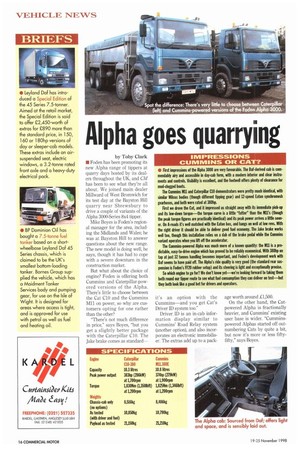Alpha goes quarrying
Page 18

If you've noticed an error in this article please click here to report it so we can fix it.
by Toby Clark
• Foden has been promoting its new Alpha range of tippers at quarry days hosted by its dealers throughout the UK, and CM has been to see what they're all about. We joined main dealer Millward of West Bromwich for its test day at the Bayston Hill quarry near Shrewsbury to drive a couple of variants of the Alpha 3000-Series 8x4 tipper.
Mike Boyes is Foden's regional manager for the area, including the Midlands and Wales; he was at Bayston Hill to answer questions about the new range. The new model is doing well, he says, though it has had to cope with a severe downturn in the construction market.
But what about the choice of engine? Foden is offering both Cummins and Caterpillar-powered versions of the Alpha. There's little to choose between the Cat C10 and the Cummins Mll on power, so why are customers opting for one rather than the other?
"There's not much difference in price," says Boyes, "but you get a slightly better package with the Caterpillar C10. The Jake brake comes as standard— it's an option with the Cummins—and you get Cat's Driver ID system too."
Driver. ID is an in-cab information display similar to Cummins' Road Relay system (another option), and also incorporates an electronic immobiliser. The extras add up to a pack
age worth around £1,500.
On the other hand, the Catpowered Alpha is fractionally heavier, and Cummins existing user base is wider. "Cumminspowered Alphas started off outnumbering Cats by quite a bit, but now it's more or less fiftyfifty," says I3oyes.
I 11/1 PIRESSIONS CUMMINS OR CAT?
• first impressions of the Alpha 3000 are very favourable. The Daf-derived cab is commendably airy and accessible in day-cab form, with a modern interior and clear instruments and controls. Visibility is excellent, and the footwell offers plenty of clearance for mud-clogged boots.
The Cummins MU and Caterpillar CIO demonstrators were pretty much identical, with similar Wilcox bodies (though different tipping gear) and 12-speed Eaton synchromesh gearboxes, and both were rated at 380Irp.
First we drove the Cat, and it impressed us straight away with its immediate pick-up and its low-down torque—the torque curve is a little latter" than the fttll's (though the peak torque figures are practically identical) and its peak power arrives a little sooner. On A-roads it's well matched with the Eaton box, and hangs on well at low revs. With the right driver it should be able to deliver good fuel economy. The lake brake works well too, though this installation relies on a dab of the brake pedal while the Cummins variant operates when you lift off the accelerator.
The Cummins-powered Alpha was much more of a known quantity: the MU is a predictable, easy-to-drive engine which has proved to be reliably economical. With 380hp on tap at just 32 tonnes handling becomes important, and Foden's development work with Oaf seems to have paid off. The Alpha's ride quality is very good (the standard rear suspension is Foden's FF20 rubber setup) and its steering is light and exceptionally precise.
So which engine to go for? We don't know yet—we're looking forward to taking them both round our tipper route to see what fuel consumption they can deliver on test—but they both look like a goad bet for drivers and operators.
















































































































